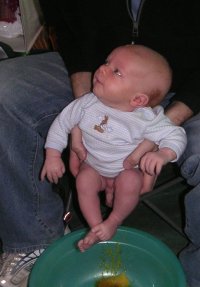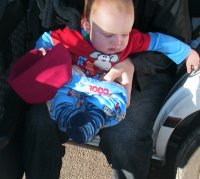|
|
|||
|
|
|
||
|
Tribal Baby Home Nappy Free Baby How to Start? How We Got Started Part Time DIAPER Free Part Time NAPPY Free Thrill of the First Catch Timing, Cues & Signs Prime Times for EC Baby's Point of View EC Clothing Directory My Grandma and EC Modern Cloth and EC Breastfeeding and EC Wearing Baby and EC EC in China Naked Bottom Time Practicing with Knickers Musing on Misses... Wee Miss Ponderings... EC at Night? Crawling and EC EC Changes - Adapt! New Signals to Spot Towards Independence Potty Practice Keeping Regular Dads Point of View Our Progress Links to Resources
Sleep Sharing |
Timing, Cues, Signs and SignalsThe basics you need to know – key terms to help you think about EC
The timing catches are easy to get, are regular times, such as when he wakes up and after feeds or at nappy changes. The cue is the "sss psss" sound that lets him know when to go. The position is also a cue, as is running water. Exhaling onto his head was a cue that developed later. The signs are the largely involuntary expressions, movements and sounds he’d regularly make when he needed to go. The uncomfortably full bladder would initially prompt these signs. Later they would become signals. The signals come later when the baby can indicate with a voluntary action that he needs to go, such as moving towards the toilet place, using sign language, and later, speech. Even at three months he occasionally signalled a need to go by looking at the bowl. From six months several times a day he'd crawl over to the pee-bowl to signal his needs. From 12 months he regularly used vocal signals. Intuition is when you get the feeling baby needs to go, and they do! Slow for me to respond to well, comes with experience as a combination of timing and subconscious awareness of subtle behaviours I think! I call it the "Baby Radar" or say "My Potty Sense is Tingling" when I feel he needs to go. "Prime Times for EC" records our experiences learning these aspects of EC. Take advantage of timing!
Being an EC detective Identifying signs is a detective process. It involves studying the baby for movements, noises and expressions they make before or during peeing. Having a list of possible signs was essential, as we'd look for a couple of them at a time - perhaps over a few days. Having an idea of his regular pees meant we could lay him in a warm place and watch for the sign before he peed, rather than trying to be 'on guard' all the time. Before he was mobile, as a tiny baby I'd have him laying in one of those rocker chairs with a nappy under his bum, so that I could watch for signs while I was making dinner. This was how I spotted him quickly kicking his legs as a sign, then caught the next few pees easily. Identifying signs is like re-reading a book Learning new signs is like when you re-read a book you enjoy, or watch a movie again and see bits you missed the first time - they were there, just not 'seen' with the first experience. With the nappy-free approach, though, new chapters keep getting added as the baby shows or develops new signs and changes or drops earlier ones. Reinforcing signs Signs baby needed to have a wee or poo. - becoming aware of baby communicating by signs in the early stages
Practising together: all three of us! An expanding awareness of signs A lesson from our cats: the 'pee button' |
||
|
|
|
||
 Tribal Baby
Tribal Baby
 Natural Infant Hygiene has been described as an art, as it is a
subtle dance between baby and parent. It involves constantly learning together
and responding to nuances in behaviour and reinforcing them to foster stronger
non-verbal communication.
Natural Infant Hygiene has been described as an art, as it is a
subtle dance between baby and parent. It involves constantly learning together
and responding to nuances in behaviour and reinforcing them to foster stronger
non-verbal communication.  'Timing' is a great way to start - you are assured of success, as littlies pee
so frequently, and
then you can use the cue sound as they go, which begins to reinforce the process for the
baby. Take them on waking, after feeds and at nappy changes. Soon enough (in
baby time) they start expecting you to take them, so they begin exhibiting
clearer signs as they wait just that little bit of time they are able to. This
time gets longer as they grow stronger. I use timing as an EC tool every day.
Wake - pee. Finish feed -pee, car trip - pee break.
'Timing' is a great way to start - you are assured of success, as littlies pee
so frequently, and
then you can use the cue sound as they go, which begins to reinforce the process for the
baby. Take them on waking, after feeds and at nappy changes. Soon enough (in
baby time) they start expecting you to take them, so they begin exhibiting
clearer signs as they wait just that little bit of time they are able to. This
time gets longer as they grow stronger. I use timing as an EC tool every day.
Wake - pee. Finish feed -pee, car trip - pee break.  Once we became aware of, or 'find' one we'd take him for a pee-opp whenever
we saw it. This reinforces it and his signs become clearer and stronger. For
example, when I became aware of him suddenly kicking his legs if he was on his
back and needed to pee, it was quite short, now it is more obvious, and he looks
closely at my face as well, as he tries to tell me! When Maven was a month old
we went on a camping holiday, and we had lots of time to observe and discuss
Maven's signs:
Once we became aware of, or 'find' one we'd take him for a pee-opp whenever
we saw it. This reinforces it and his signs become clearer and stronger. For
example, when I became aware of him suddenly kicking his legs if he was on his
back and needed to pee, it was quite short, now it is more obvious, and he looks
closely at my face as well, as he tries to tell me! When Maven was a month old
we went on a camping holiday, and we had lots of time to observe and discuss
Maven's signs:  He
wouldn't stay attached during a feed - he pops on and off, fussing at the
boob.
He
wouldn't stay attached during a feed - he pops on and off, fussing at the
boob..jpg) Over time there has been an expanding awareness of his signs, and increasing
complexity of body language 'signs' to interpret. This makes it easier as time
goes on. For instance, at night at first I responded if he was kicking me with
his legs, the squirming was awaking me. Now, I find myself awake, and can listen
just to his breathing to tell if he needs to go or not!
Over time there has been an expanding awareness of his signs, and increasing
complexity of body language 'signs' to interpret. This makes it easier as time
goes on. For instance, at night at first I responded if he was kicking me with
his legs, the squirming was awaking me. Now, I find myself awake, and can listen
just to his breathing to tell if he needs to go or not!